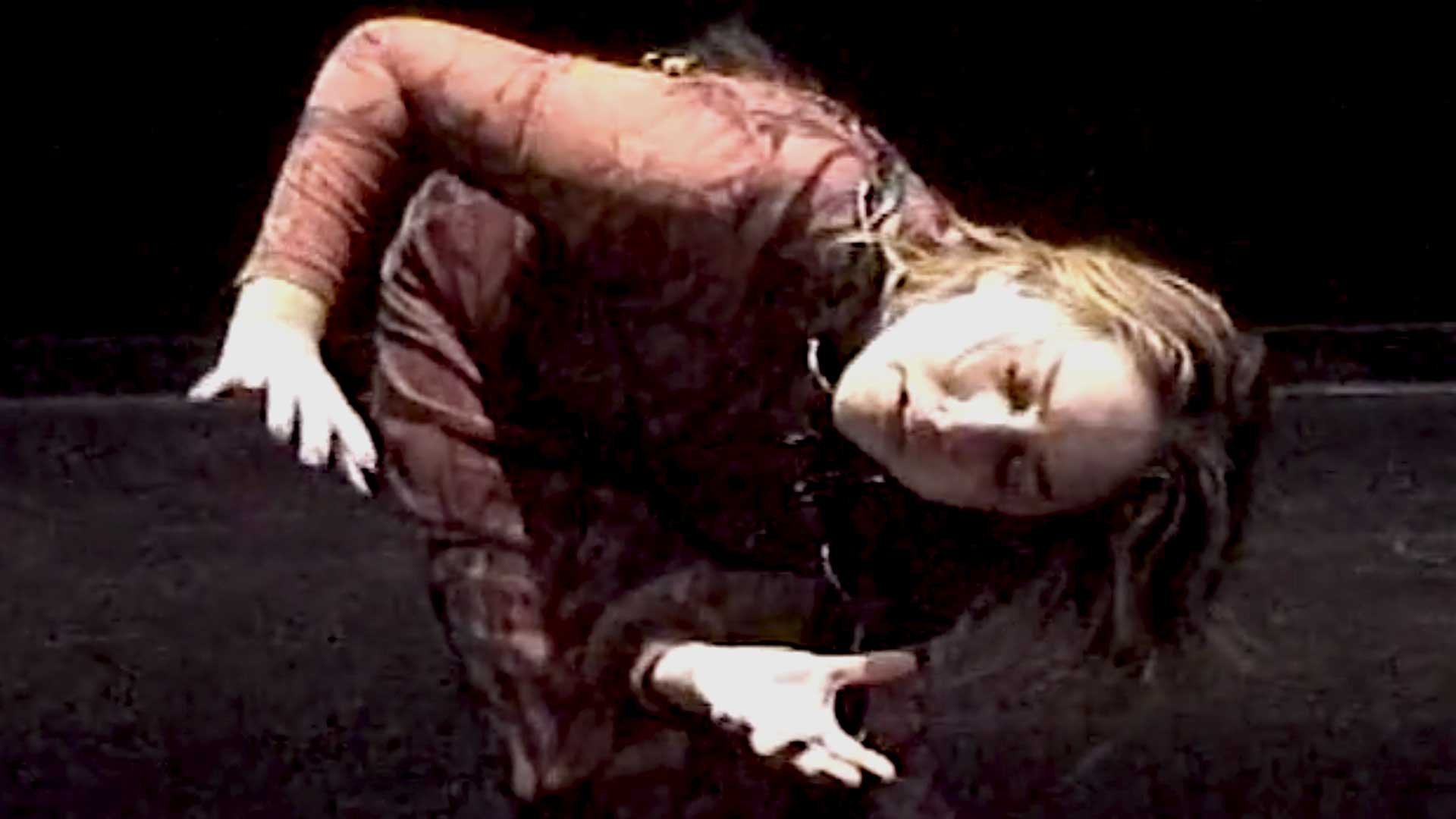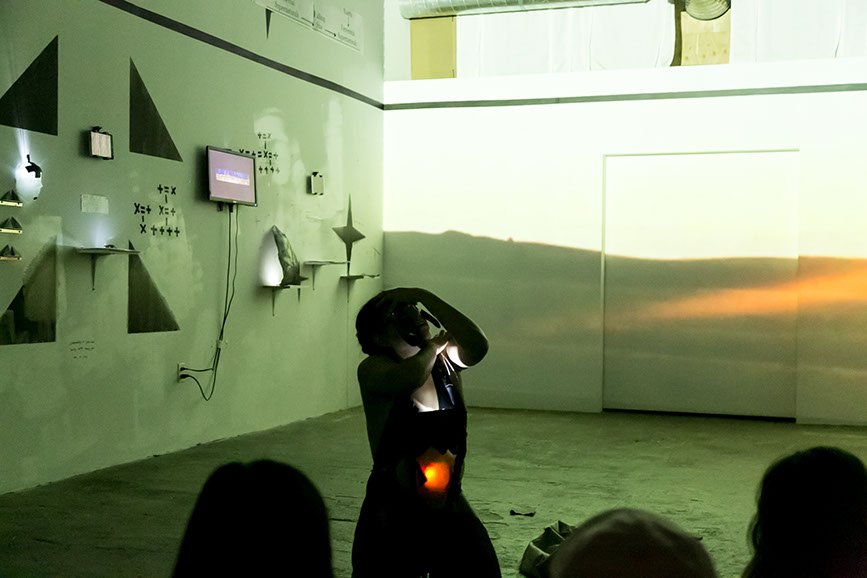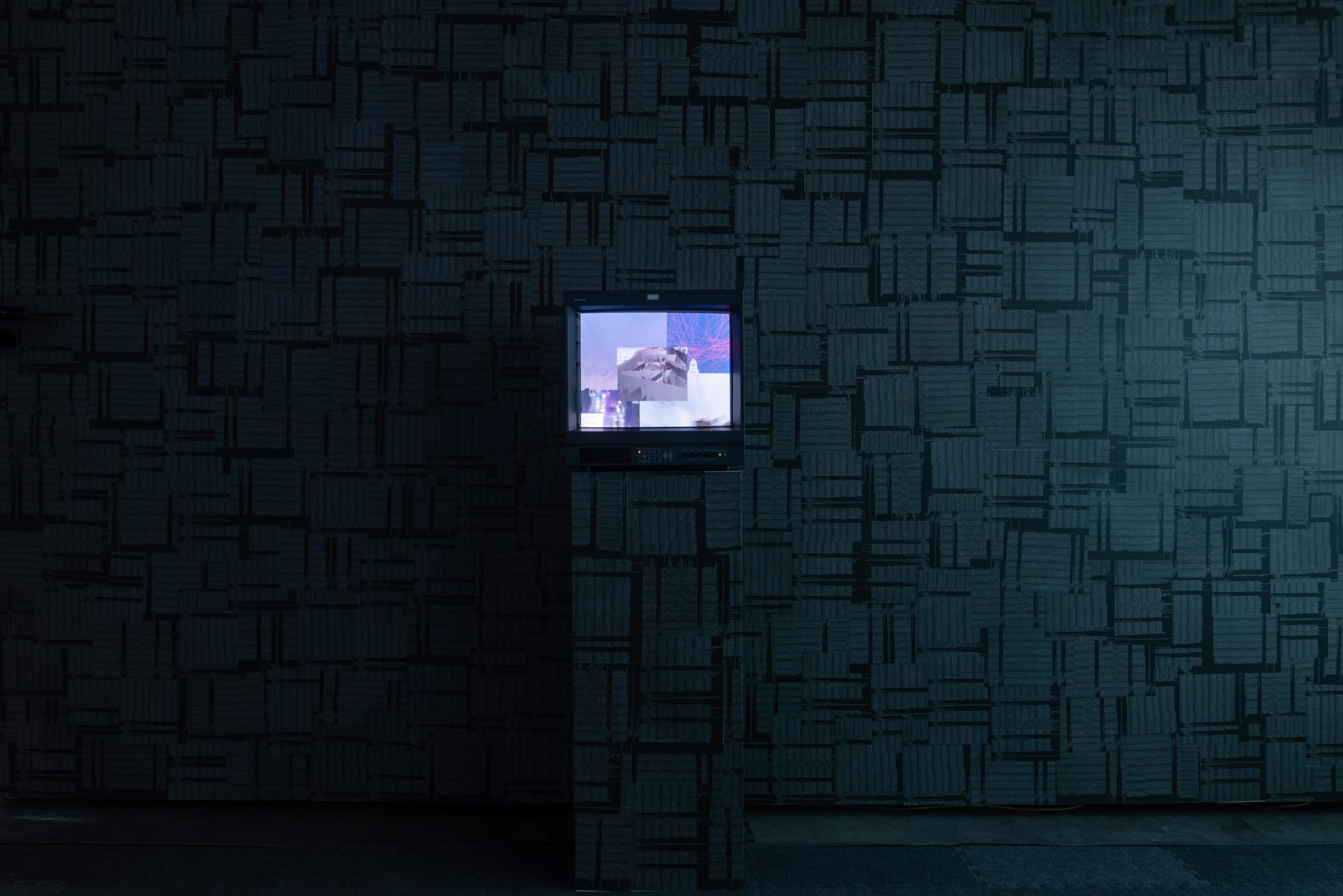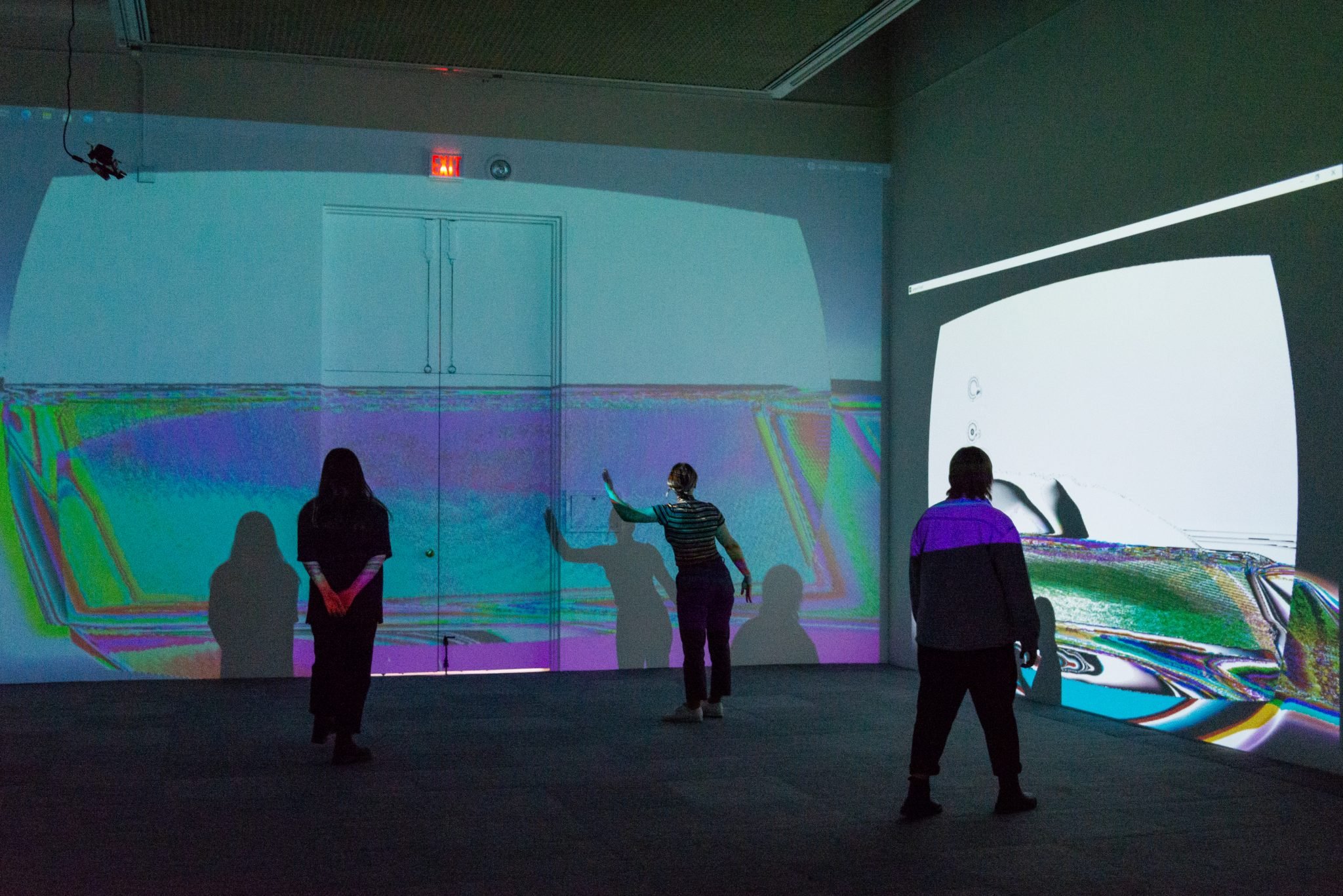Take Care, My Boy, 2021
Take Care, My Boy, 2021, Performance, 18 minutes, Kite. Hair braid interface, a years worth of samples, violin, Minitaur.
Description
A newly developed A.I. hair-braid interface performance, created with a collage of text and field recordings taken over the past six months. This piece includes experiments with A.I. text and machine learning interactions.
Previous Showings
“Electric Fields – gestural sonic expansions,” Vancouver New Music Festival 2021. October 28 - November 10, 2021.
Three Diffractions of LA, 2020
Three Diffractions of LA, video and composition, 2020.
Description:
Kite, aka Suzanne Kite, offers an intimate personal essay and audio/video triptych that weaves a speculative narrative across eras and locations in Los Angeles and the history of the U.S. "Three Diffractions of LA" sees the Indian Relocation Act, the formation of the LAPD, the DTLA rave scene, and the disappearance of relatives through a metonymic kaleidoscope, a collapsing neutron star. Her publication is part dream, part lullaby, part drone, and situates reality as something stretched beyond that which we can see at the horizon.
Le Musée d’art contemporain de Montréal Intersects Makȟá Oníya, 2020
Image Credit: Guy L’Heureux
Image Credit: Guy L’Heureux
Description
In this sculpture, the gallery walls, ceiling, and floors interrupt the physical space of a three-dimensional cube of United States Geologic Service survey data. The walls cut the sculpture into smaller and smaller parts, in the gallery as well as protruding like an infection, hidden throughout the building, like two 3D cubes passing through each other in digital space. The fractured sculpture is made of one whole section of data of Wind Cave National Park, the place where the Lakȟóta people emerged from the earth, becoming buffalo and human. The sculptures are 3D renderings with resin-cured carbon fibre cloth draped over their forms.
During the opening of the show, improvising musicians read the textures and forms of the sculptures as a score, performing, tactilizing, and sonifying the visualized geologic data. Performance during opening is recorded and played back through small white speakers on either side of the sculptures in the gallery.
One sculpture emerges from the corner of the ceiling, one from directly below on the floor, and five small sculptures emerge from crevices throughout the atrium.
Artworks
Le Musée d’art contemporain de Montréal Intersects Makȟá Oníya, installation. Kite in collaboration with Devin Ronneberg, 2020. Installation, seven sculptures, carbon fibre, USGS data.
Le Musée d’art contemporain de Montréal Intersects Makȟá Oníya, composition, performed by Eyvind Kang. Kite, 2020. composition.
Previous Showings
“La Machine qui Enseignait des Airs aux Oiseaux ”, Le Musée d’Art Contemporain de Montréal, Montreeal, QC, Canada, January 2021 - April 4, 2021
INYAN/ZINTKALA/INYAN KAGAPI (STONES MAKE BIRDS MAKE STONES), 2021
Description
Created in response to Martha Tuttle’s installation, A stone that thinks of Enceladus, on view at Storm King Art Center (New Windsor, New York) from July 15, 2020, through November 8, 2021, Kite’s video work INYAN/ZINTKALA/INYAN KAGAPI (STONES MAKE BIRDS MAKE STONES) utilizes StyleGAN to create generated photographs of stones trying to reassemble birds. Sounds in the work include recordings of a Hudson River estuary, the river lapping at the feet of a poet, the Taos hum, a Jacob’s Ladder electrical device, the rehearsal of a conch shell sextet, a harp excerpt from a previous work, and the artist’s voice. The voice speaks in the messy verbalizations generated by GPT-2, trained on texts from Storm King Art Center’s landscape information and poetry by Gabriel Kruis in collaboration with Martha Tuttle.
This video work interrogates ideas of landscape as a reflection of the soul of the settler: non-Indigenous, white America’s inability to rest until it fully owns the land. It cannot rest until achieving indigeneity. This colonial desire—the quest for Indigeneity—is a quest for a new religion and a new mythology. Such stories are formed and re-formed through traumatic, apocalyptic events that defy human comprehension, such as the genocide of millions of humans and nonhumans. The fear of the unknown grows closer and closer in America—a fear that shapeshifts, haunts, and terrorizes—like a being in the dark, or the savage in a darkly forested periphery. Ethical relations with nonhumans—deer, birds, stones, machines, and extra-terrestrials—are possible, but humanity would have to choose to understand nonhumans through ontologies that lead to ethical relationships. Lakota ontologies, mythologies, and cosmologies already include the nonhuman and extra-terrestrial. These understandings are not based in fear of the unknown, but respect for the unknown.
Previous Showings
New Nature, Goethe Institute,
• Berlin from November 16 to December 6, 2020
• Montreal from November 16 to December 6, 2020
• New York City from December 15, 2020 to January 8, 2021.
INYAN/ZINTKALA/INYAN KAGAPI (STONES MAKE BIRDS MAKE STONES), JOAN Los Angeles, Presented by Art Papers, May 6, 2023.
Eadweard Muybridge, 2020
EADWEARD MUYBRIDGE: HUMAN AND ANIMAL LOCOMOTION
WITH A LIVE SCORE BY KITE AND DEVIN RONNEBERG
Description
Presented by the Los Angeles Contemporary Museum of Art and The Autry Museum of the American West
In looking at the interconnected histories of photography and filmmaking practices, FILM at LACMA is highlighting the work of Vera Lutter. From February 2017 to January 2019, New York-based artist Vera Lutter was invited by LACMA to work in residence at the museum, creating a new body of work examining the campus architecture, galleries, and collection holdings. Vera Lutter: Museum in the Camera features the compelling photographs made during her two-year residency.
Lutter uses one of the oldest optical technologies still in use, that of the camera obscura. Before the invention of photography, it was known that if light traveled through a tiny hole into a darkened room, an image of the external world (off which the light rays had reflected) would re-form upside down on a wall opposite the tiny opening. By building room-sized cameras and placing unexposed photo paper across from a pinhole opening, Lutter has adopted the camera obscura as her singular working method, resulting in photographs with an ethereal, otherworldly beauty.
Early camera techniques, such as Lutter’s, are also foundational to what later became known as cinema. Similar to the camera obscura, the history of moving image practices date back millennia. However, the moving image as we know it now was not developed until 1872 when the former governor of California Leland Stanford hired photographer Eadweard Muybridge to prove that all of a horse’s hoofs left the ground while running. After validating Leland’s hypothesis, Muybridge further developed his study of the motion of horses and in 1978 created one of the first steps toward a moving image by placing 24 shutter-controlled cameras to record the galloping of a horse. Muybridge had images from his motion studies copied in the form of silhouettes onto a disc, to be viewed in a machine he had invented, which he called a "zoopraxiscope." This device was later regarded as an early movie projector, and the process as an intermediate stage toward motion pictures. Similar to Lutter’s work, these early motion pictures contain the spirit and the spectral quality of the moment in which they were captured.
Celebrating the convergence of film and its place within the history of the American West, we will be co-presenting a live stream screening of the motion studies of Muybridge with The Autry Museum of the American West on May 15 at 7 pm. Accompanying this screening will be a live score by Kite and Devin Ronneberg.
Previous Showings
Eadweard Muybridge: Human and Animal Locomotion, with a Live Score by Kite, Los Angeles Contemporary Museum of Art (LACMA), May 15, 2020.
Lecture on Two Locations, 2016
Lecture on Two Locations. Site Specific experimental lecture/performance. Kite, 2016. 20 minutes. Printed handouts, projections, text.
A mapping lecture or workshop of two unspecified locations with thirteen Western methods, i.e. aerial, geological, chemical, archaeological, etc. This workshop or lecture speculates on the ability of a location to be mapped. Lecture format, slideshow, sound, with annotated research packets for the audience. Developed at the Milton Avery Graduate School of Fine Art, performed at Intersite Festival, Calgary, AB, November 2016.
This work is indebted to Taylor Harder, the New York State Museum, and especially the research and writing of Jesse Salus of the Ring Road Blog. https://calgaryringroad.wordpress.com
Call to Arms, 2019
Description:
Suzanne Kite with Althea Thauberger, Score for soloist James Chilton and the HMCS York Band. Score, Part of Call to Arms, Althea Thauberger and Suzanne Kite,
2019. Sound/Video Installation. Commissioned for the inaugural 2019 Toronto Biennial.
Thauberger + Kite’s installation Call to Arms features audio and video recordings of their rehearsals with Her Majesty’s Canadian Ship (HMCS) York band in advance of a live performance of four musical scores by Kite during the Biennial’s opening weekend in addition to the band’s own repertoire. Boasting the country’s only conch shell sextet, the band will play in the drill hall housed within the Navy’s “stone ship,” a highly resonant space that is itself played like an instrument.
Commissioned by the Toronto Biennial of Art and presented in partnership with HMCS York. Made possible with the generous support of Partners in Art and Ann and Harry Malcolmson.
Althea Thauberger + Kite were the recipients of an Honourable Mention prize for their work commissioned for the Toronto Biennial of Art.
Artworks:
Call to Arms: Battle Cry (Gift to the Shell Ensemble), performance, Kite with Althea Thauberger, 2019.
Call to Arms: Battle Cry (Gift to the Shell Ensemble), Music Score, Kite with Althea Thauberger, 2019.
Previous Showings:
Toronto Biennale
Suzanne Kite with Althea Thauberger, Score for soloist James Chilton and the HMCS York Band.
Score, Part of Call to Arms, Althea Thauberger and Suzanne Kite,
2019. Sound/Video Installation.
Commissioned for the inaugural 2019 Toronto Biennial.
Press / Reviews:
Taylor, Kate. “How the Toronto Biennale Will Stand Out in a Crowded Landscape.” The Globe and Mail. 22 September 2019. Link
Fung, Amy. “Amy Fung on the First Toronto Biennale of Art.” Artforum. 30 October 2019. Link
“The Best of Toronto’s Art Scene 2019”. Now Toronto. Published: December 10 2019. Link
Best Art Performance- Call to Arms
“Thauberger and kite Q+A”. Partners in Art. Published: November 26 2019. Link
Something is Coming, 2018
Image Credit: Mike Tan
Description:
Something is Coming, done in collaboration with Nathan Young, is a site specific sound performance which listens into the electrical grid. Utilizing ground loop noise, field recordings, digital processing, and analog manipulation, Kite and Young propose a way to listen through the grid to the source. This form of listening is not a metaphor, but a way to access and reimagine power systems. This mode of listening is a relinquishing of belief. To listen to the grid and hear the physical source of power is to not mistake the map for the land itself. This form of listening provides an opportunity to hear and think beyond colonial constraints of cartography and large-scale exploitations of natural resources.
Artworks:
Something is Coming, performance, Kite with Nathan Young, 2018. Ground loop noise, field recordings, digital processing, and analog manipulation.
( x ) x + [ ( x ) x { x } x x ] { x } +, 2016
Image credit: Iris Ray
Description:
Comprising an installation and a performance, the work ( x ) x + [ ( x ) x { x } x x ] { x } + (pronounced “Sources”) explores the relationship between the artist’s body and the entanglement of lies, fiction, oral history, mythology, and ethnography that surround Lakota religion. Developed from an obsessive hyper-structure and information derived from “poor” sourcebooks, the project delves into attempts to qualify Oglala religion into structural and clarified terms. Four female characters who have shaped the Lakota cosmology of the present—Škan, Falling Star, Double Face and Sacred White Buffalo Calf Woman—are conjured through leather and carbon-fibre sculptures, animation, sound composed by Kite and Aerial, home video, wearable sculptures and technologies, scores and movement. The differences between telling stories, telling lies, and creating fiction are wrapped up in the precarious status of a display labeled as "Lakota."
Artworks:
PERFORMANCE/INSTALLATION | 15 MINUTES | MULTIMEDIA PERFORMANCE PIECE, WITH PROJECTIONS FOR 4 GALLERY WALLS AND GALLERY FLOOR.
( x ) x + [ ( x ) x { x } x x ] { x } + , performance, Kite, 2016.
Documentation: Banff Centre for Arts and Creativity (Jackson Polys), Wayside LA (Iris Ray), Sightings, Concordia University (Robin Simpson).
( x ) x + [ ( x ) x { x } x x ] { x } + , multimedia installation, Kite, 2016. Includes four sculptures, four paintings, six videos, and various acetate signage.
People You Must Look at Me, 2015
Description:
People You Must Look at Me, Performance, Kite, 2015. 15 minutes. Includes floor projection, quad sound, body interface.
People You Must Look at Me or Coyote and Badger Were Neighbors or The Origins of Eternal Death is an experimental improvised performance and installation project investigating the limits of mapping the Earth, mapping data, and mapping the body. Chiastically structured as a cocoon, this piece wraps itself around a recording from my biological mother’s funeral, telling and retelling the events with alternative stories, mappings, and levels of control over the sound. In performance, the interface effects the sounds differently in each section. This piece was my first attempt with the body interface and would lead to a deeper exploration of the problem of contextualizing my body, at the places where sonification fails to communicate, into the realms of truth, belief, and Lakota epistemology. The improvisations included in the recording are: saxophone by Matana Roberts, fiddle by Alicia Svigals, harp by Marilu Donovan, body interface and Serge synthesizer by Kite, singing by Loons of Turtle Island.
Makȟóčheowápi Akézaptaŋ (Fifteen Maps), 2021
Description
Kite’s work examines how artificial intelligence often reproduces the logics of coloniality: inheriting the structure of colonial knowledge systems, AI can flatten land, people, and lifeworlds into objects of knowledge — data points to be extracted. Kite intervenes in that structure by imagining possibilities for Indigenous epistemologies of AI. In one essay, Kite asks what it would mean to build a computing device according to the Lakota model of the Good Way transmitted by her family members: in “consultation with a committee of knowledge keepers,” toward algorithms, code, and software that combine to work for the good of Seven Generations into the future. For the interactive installation “Makȟóčheowápi Akézaptaŋ (Fifteen Maps),” LIDAR remote sensing is used to detect the distance of the visitor’s body from the screen, triggering changes in the video and audio content displayed. Its content draws from Kite’s ongoing research into Cruger Island, a site along the Hudson River. The island was “purchased” in the 19th century by John Cruger, who used it as a backdrop for stolen Mayan ruins he transported as casts from Honduras. By the 1960s, Cruger Island had become a place for archaeological excavations that displaced Indigenous artifacts and remains, which would be transferred to the New York State Museum.
Invoking Kite’s earlier “Lecture on Two Locations,” this piece considers how cartography, archaeology, excavation, and the scientific disciplines are all implicated in the legacies of colonial violence. Each develops classificatory schema for parsing sites and peoples in order to subsequently claim ownership of them. Confronting those histories, Kite’s installation “turns an Indigenous gaze back on” these knowledge systems and explores how AI might function as a conduit for alternative ways of nonhuman knowing.
Artworks
Makȟóčheowápi Akézaptaŋ (Fifteen Maps), 2021, Kite. Monitor, PC, Speakers, Printout.
Previous Showings
“Encoding Futures: Critical Imaginaries of AI,” OxyArts on York, September 16 - November 19, 2021, Los Angeles, CA.
LA Birdwatchers, 2021
Description
LA Birdwatchers (Kite, Ladan Mohamed Siad, Aljumaine Gayle, Nick Shapiro, Michelle Servin), LA Birdwatchers, 2021. Video, 11 minutes.
LA Birdwatchers is a film that was shot and edited by Kite with animation provided by technologist Ladan Mohamed Siad, designer Aljumaine Gayle, UCLA anthropologist Nick Shapiro, and mapper Michelle Servin. This group of artists and technologists was a working group known as LA Birdwatchers. The goal of this art-science project was to capture the sonic stress of aerial surveillance, its areas of concentration, and its disproportionate contributions to climate change. Since the creation of this film UCLA's Carceral Ecologies Lab and Stop LAPD Spying Coalition have filed a lawsuit against the Los Angeles Sheriff's Department
Previous Showings
LA Birdwatchers, in collaboration with Aljumaine Gayle, Ladan Mohamed Siad, and Nicolas Shapiro. “Contingent Systems: Art And/As An Algorithmic Critique.” Alberta University of the Arts, Calgary, Alberta, Canada.
LA Birdwatchers, in collaboration with Aljumaine Gayle, Ladan Mohamed Siad, and Nicolas Shapiro. Presented at “Machine Bodies (Is Cyborg Good or Evil?),” part of the Vector Festival 2022: Glitch, presented at InterAccess. Toronto, Ontario, Canada. July 14 - August 13, 2022.
The Last of the Lemurians, 2021
Description
The Last of the Lemurians, New Red Order and Kite, video and immersive installaton, 2021.
For a short period in 1999, the Archæoraptor was believed to be the missing link between birds and non-avian dinosaurs. During a National Geographic press conference, and without prior peer review, the newly discovered fossil was announced to have originated in the Early Cretaceous in today’s China. Soon, however, the Archæoraptor was revealed to be a forgery, a chimera created by combining bones of prehistoric birds and terrestrial dinosaurs.
New Red Order’s exhibition at Centre CLARK interrogates the politics of power absorbed into forged histories. The artist collective directs our attention to how speculation can cement into truth and history becomes naturalized, sometimes with devastating consequences. NRO unpacks the now-debunked theosophist theory that there was once a continent stretching from the east coast of Africa through the Indian Ocean and all the way to the Pacific. Proponents of the supposed supercontinent, referred to as Lemuria, claimed that it predated the currently known configurations of tectonic plates. Occult thinkers—including philosopher Helena Blavatsky—propagated false information suggesting that the people inhabiting this original land, Lemurians, were the purest—the most indigenous—humans. Such claims were intended to promulgate racist theories with the aim of establishing “Aryans” as the authentic first people.
NRO critically and humorously punctures these false beliefs, exposing them as attempts to create a lineage through which white settlers could assert themselves as native, without having to confront the genocide of Indigenous peoples. The resulting exhibition is critical of the chimeras of history and simultaneously speculative in its own right.
In the video installation The Last of the Lemurians, NRO approaches the myth of Lemuria, which has it that a continent situated in the Indian Ocean, now submerged, was the cradle of humanity and the Lemurians were the first people on Earth. Several theories related to white supremacy derive from this myth, including that of “root races” devised by Russian theosophist Helena Blavatsky (1831–91), who invented a hierarchy of races and promoted the Aryan doctrine. Inspired by New Age Lemurian beliefs built on Blavatsky’s concept, NRO proposes a counter-reading of these racist fictions. The Last of the Lemurians is articulated around two geological formations each of which is the subject of legend: Mount Shasta, a volcano in California, which supposedly harbours a secret city populated by superior blond beings from the lost continent, and the Hawaiian island of Kauai, purportedly once a capital of Lemuria. The work makes symbolic use of two materials connected to these geographies: lava, a destructive material in its liquid state and bearer of life in its solid state, and crystal, an object synonymous with purity that, in its liquid state, can flow like water but also refract like ice. NRO metamorphizes the moving, sometimes toxic, dimension of historical narratives and their crystallization in the collective imagination. A hybridization of the native and the alien, The Last of the Lemurians makes light out of colonial desires, proposing an alternative to the romanticization of Indigeneity. Here, the fluidity of materials echoes the redeeming metamorphosis of exoticizing phenomena into a multitude of reciprocal relations.
Previous Showings
“Momenta Biennale 2021: Sensing Nature”, curated by Stephanie Hessler presented at Centre Clarke, Montréal, QC. September 8 - October 16, 2021.
Press/ Reviews
Didier Morelli. “MOMENTA 2021 Centres Indigenous and Nonhumanist Notions of Nature.” Frieze Magazine. 30 September 2021. Link.
Jane Wilkinson. “Natural Causes.” Artforum. 20 October 2021. Link
Brighter Than the Brightest Star I've Ever Seen, Kite, 2018
Description:
Script for experimental lecture, performed with the New Red Order at the Whitney Museum of American Art in 2018. The words in italics are taught in Lakota to the audience, who do not know their translations until the final repeated litany. This piece explores the transmission of truth through manipulation.
Artworks:
Brighter than the Brightest Star I’ve Ever Seen, performance, Kite, 2018, 15 minutes. Video, sound, experimental lecture, audiovisual projection.
Brighter than the Brightest Star I’ve Ever Seen, Script, Kite, 2018, 15 minutes. Experimental lecture and poetry.
Brighter than the Brightest Star I’ve Ever Seen, Slideshow, Kite, 2018, 15 minutes. Audiovisual component.
Brighter than the Brightest Star I’ve Ever Seen, Endless acknowledgement, Kite, 2018, 15 minutes. Experimental lecture.
Previews Showings:
The New Red Order Presents: The Savage Philosophy of Endless Acknowledgement. Whitney Museum of American Art, 2018.
The Informants, in collaboration with the New Red Order. Clark Center, December 2019
Better Off Alone, 2018
Description
Better Off Alone, Kite, Installation, Projector, Computer System, Keyboard, 2018.
Better Off Alone is an installation work and permanent chatroom which uses Blu Mar Ten's sample pack ``jungle jungle`` to sonify a chatroom. Displayed on the wall are the artist's collection of YMCA Indian Princesses, Pocahontas, and rave memorabilia. This is an installation for a projector, a computer with special software, and a public chatroom. In this documentation, you are seeing what happens when people in the installation type on the computer. Typing in the chatroom is sonified and the artist and anyone who wants to chat can join remotely.
Previous Showings:
Interaccess Gallery: Loner Culture, featuring Thirza Cuthand, Kite, and Fallon Simard. Curator Lindsay Nixon. Sep 14 - Oct 27, 2018. Toronto, Ontario
Exhibition Text: Loner Culture, curated by Lindsay Nixon @ Interaccess Gallery
BANFF Digital Summit: Arts, Culture, and Digital Transformation Summit, November 22-24, 2019. Banff, Alberta.
Digital Anti-Matter Anti-Manifesto, a programming intervention by gijiit. ACE Arts, Summer 2021, Winnipeg, Manitoba.
“Technology in Art, an Art House show,” Lost in America Gallery, February 5 - 20, 2022, Tulsa, Oklahoma.
Reviews/ Reviews:
“Loner Culture 2.0- Better Off Alone - Kite.” Now Toronto. 16 April 2021. Link
















![( x ) x + [ ( x ) x { x } x x ] { x } +, 2016](https://images.squarespace-cdn.com/content/v1/641c9e79560ce0068fb84a8c/1687805548098-RRI0TZUAZIACCGGJIVFH/0108-0355.jpeg)












